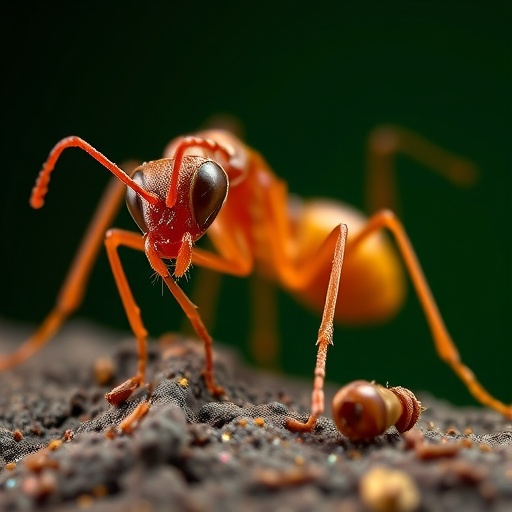In the intricate world of ant colonies, communication through scent is not just a tool but a necessity for survival and social order. A groundbreaking study published in Nature by researchers at New York University unveils a remarkably sophisticated genetic mechanism underlying ants’ unparalleled olfactory capabilities. This discovery sheds light on how ants manage to express only one olfactory receptor gene per neuron out of hundreds, enabling their acute sense of smell essential for their complex social interactions.
Ants rely heavily on pheromones, chemical signals that orchestrate a wide array of behaviors including foraging, colony defense, and caste differentiation. The ability to detect and interpret these signals depends on the selective expression of olfactory receptor genes in individual sensory neurons. Disruption of this finely tuned system leads to communication breakdowns within the colony, resulting in chaos and internecine aggression. Bogdan Sieriebriennikov, the study’s lead author, emphasizes the catastrophic consequences when ants lose their sense of smell, illustrating the delicate balance maintained within their colonies.
Ant genomes contain up to 500 olfactory receptor genes — a number that dwarfs the olfactory receptor repertoires found in many other organisms. This genetic complexity poses a formidable challenge: how does each olfactory neuron commit to expressing a single, unique receptor gene among a vast cluster? Unlike fruit flies, whose genomes encode predetermined receptor choice, or mice, which rely on complex probabilistic systems, ants have evolved an alternative biogenetic solution to this conundrum.
To tackle this mystery, the researchers mapped gene expression across individual olfactory neurons, revealing a striking pattern described as a “staircase.” Some neurons expressed the last gene in a cluster, others the last two, and some three or more downstream genes. This gradient suggested a novel regulatory process governed not by predetermined genetic fate but by a dynamic transcriptional mechanism.
Central to this mechanism is what the authors term the “runaway bulldozer” effect. Transcription, the process by which DNA sequences are copied into messenger RNA, typically halts at each gene boundary. However, in the genomic clusters of ant olfactory receptors, this transcriptional machinery persistently transcribes through multiple downstream genes within a cluster without stopping, physically suppressing their activation. This relentless progression effectively silences the downstream receptors.
But the puzzle extends further: how is the expression of genes upstream of the chosen receptor also repressed? The research unveiled a fascinating antisense RNA mechanism. The selected receptor gene simultaneously initiates transcription in the opposite direction, producing antisense RNA that suppresses the upstream genes. Thus, the selection of any single receptor gene initiates a dual repression cascade — the downstream genes are blocked by the bulldozer-like transcriptional read-through, and the upstream genes are silenced by antisense transcription. This dual interference guarantees that each olfactory neuron expresses only one receptor gene.
This regulatory strategy, while seemingly inefficient due to its extensive transcriptional activity, exemplifies nature’s pragmatic problem-solving. Evolution often favors solutions that work reliably over those that are elegant or energy-efficient. “The ‘runaway bulldozer’ is not an economical way of controlling genes,” notes Sieriebriennikov. Nonetheless, this system’s robustness and simplicity have cemented it in the ants’ genetic architecture.
The implications of this discovery ripple beyond insect biology; it hints at fundamental principles of gene regulation and evolutionary convergence. In humans, protocadherin genes, crucial for proper neuronal wiring, are organized in similar genomic clusters and follow a “one gene per neuron” rule. These genes also employ antisense transcription to ensure the exclusive expression of a single protocadherin variant per neuron. The parallel between ants and humans, despite their evolutionary distance, suggests a shared molecular strategy devised by nature to resolve complex gene expression challenges.
Olena Kolumba, a co-author of the study, highlights the elegance of the bulldozer mechanism in its simplicity and effectiveness. She suggests that this logic may represent a basic biological principle applied across diverse species to maintain specific gene expression patterns in clustered genomic regions. Such findings emphasize the value of investigating seemingly unusual or “weird” data signals, which, when properly explored, can unveil profound biological insights.
This discovery also raises broader questions about the evolution of gene regulatory mechanisms in sensory systems. The intricate interplay of transcriptional interference and antisense RNA in ants may inspire new models for understanding gene regulation in other multicellular organisms, particularly in tissues where precise, cell-specific gene expression is essential for function.
By mapping olfactory receptor expression and uncovering the regulatory architecture behind it, this research pioneers a new frontier in sensory biology. It exposes the molecular choreography that allows ants an extraordinary sensory precision fundamental to their ecological success. As such, it not only enriches our understanding of ant neurogenetics but also provides valuable paradigms for studying gene regulation in complex neuronal networks.
The authors, including Sieriebriennikov, Kolumba, Claude Desplan, and colleagues, hope this work will foster a greater appreciation for the unforeseen complexity and creativity inherent in evolutionary biology. Their findings underscore that even mechanisms deemed inefficient by conventional standards can prevail when they fulfill critical biological functions with reliable outcomes across evolutionary timescales.
This research was funded by the National Institutes of Health, Tamkeen under the NYU Abu Dhabi Center for Genomics and Systems Biology, and the Human Frontier Science Program. It was conducted collaboratively by teams at New York University, the University of Miami, and the University of Florida.
Subject of Research: Ant olfactory receptor gene regulation
Article Title: Transcriptional interferences ensure one olfactory receptor per ant neuron
News Publication Date: 22-Oct-2025
Web References: DOI: 10.1038/s41586-025-09664-x
Image Credits: Ching-Han Lee, Olena Kolumba, Heeseung Yang
Keywords: Olfactory receptors, Neuroscience, Sensory systems, Gene regulation




